A Facile Synthesis of RGO-Ag2MoO4 Nanocomposites for Efficient Lead Removal from Aqueous Solution
Abstract
:1. Introduction
2. Results and Discussion
Adsorption Study
3. Experimental Section
Synthesis of Reduced Graphene Oxide Modified Silver Molybdate Ternary Nanocomposite (RGO–Ag2MoO4 NCs)
4. Conclusions
Supplementary Materials
Author Contributions
Funding
Institutional Review Board Statement
Informed Consent Statement
Data Availability Statement
Acknowledgments
Conflicts of Interest
References
- Qamruzzaman; Nasar, A. Degradation of acephate by colloidal manganese dioxide in the absence and presence of surfactants. Desalin. Water Treat. 2015, 55, 2155–2164. [Google Scholar] [CrossRef]
- Qamruzzaman; Nasar, A. Kinetics of metribuzin degradation by colloidal manganese dioxide in absence and presence of surfactants. Chem. Pap. 2014, 68, 65–73. [Google Scholar] [CrossRef]
- Özacar, M.; Şengil, İ.A.; Türkmenler, H. Equilibrium and kinetic data, and adsorption mechanism for adsorption of lead onto valonia tannin resin. Chem. Eng. J. 2008, 143, 32–42. [Google Scholar] [CrossRef]
- Boudrahem, F.; Aissani-Benissad, F.; Soualah, A. Adsorption of Lead(II) from Aqueous Solution by Using Leaves of Date Trees as an Adsorbent. J. Chem. Eng. Data 2011, 56, 1804–1812. [Google Scholar] [CrossRef]
- Nasar, A. Treatment of acetamiprid insecticide from artificially contaminated water by colloidal manganese dioxide in the absence and presence of surfactants. RSC Adv. 2014, 4, 62844–62850. [Google Scholar]
- Mashkoor, F.; Nasar, A. Environmental application of agro-waste derived materials for the treatment of dye-polluted water: A Review. Curr. Anal. Chem. 2021, 17, 904–916. [Google Scholar] [CrossRef]
- Nasar, A. Utilization of tea wastes for the removal of toxic dyes from polluted water—A review. Biomass Convers. Biorefinery 2021, 13, 1399–1415. [Google Scholar] [CrossRef]
- Isaac, R.; Siddiqui, S.; Aldosari, O.F.; Kashif Uddin, M. Magnetic biochar derived from Juglans regia for the adsorption of Cu2+ and Ni2+: Characterization, modelling, optimization, and cost analysis. J. Saudi Chem. Soc. 2023, 27, 101749. [Google Scholar] [CrossRef]
- Gupta, K.; Joshi, P.; Gusain, R.; Khatri, O.P. Recent advances in adsorptive removal of heavy metal and metalloid ions by metal oxide-based nanomaterials. Coord. Chem. Rev. 2021, 445, 214100. [Google Scholar] [CrossRef]
- Kapnisti, M.G.; Noli, F.G.; Arvanitidis, J.; Hatzidimitriou, A.G. Thermally modified molybdenum oxide as a potential sorbent for the removal of metal cations from aqueous solutions. J. Radioanal. Nucl. Chem. 2016, 307, 555–565. [Google Scholar] [CrossRef]
- Wang, M.; Song, X.-X.; Cheng, X.-L.; Zhou, X.; Zhang, X.-F.; Cai, Z.; Xu, Y.-M.; Gao, S.; Zhao, H.; Huo, L.-H. Highly selective and efficient adsorption dyes self-assembled by 3D hierarchical architecture of molybdenum oxide. RSC Adv. 2015, 5, 85248–85255. [Google Scholar] [CrossRef]
- Della Rocca, D.G.; Peralta, R.M.; Peralta, R.A.; Peralta Muniz Moreira, R.d.F. Recent development on Ag2MoO4-based advanced oxidation processes: A review. React. Kinet. Mech. Catal. 2021, 132, 1–35. [Google Scholar] [CrossRef]
- Nobakht, A.; Jafari, D.; Esfandyari, M. New insights on the adsorption of phenol red dyes from synthetic wastewater using activated carbon/Fe2(MoO4)3. Environ. Monit. Assess. 2023, 195, 574. [Google Scholar] [CrossRef] [PubMed]
- Pournamdari, E.; Niknam, L. Applicability, adsorbent chitosan@Fe2 (MoO4)3 nanocomposite for removal of textile reactive red198 dye from wastewater. Desalin. Water Treat. 2024, 317, 100268. [Google Scholar] [CrossRef]
- Iqbal, Z.; Tanweer, M.S.; Alam, M. Reduced Graphene Oxide-Modified Spinel Cobalt Ferrite Nanocomposite: Synthesis, Characterization, and Its Superior Adsorption Performance for Dyes and Heavy Metals. ACS Omega 2023, 8, 6376–6390. [Google Scholar] [CrossRef]
- Velusamy, S.; Roy, A.; Sundaram, S.; Kumar Mallick, T. A review on heavy metal ions and containing dyes removal through graphene oxide-based adsorption strategies for textile wastewater treatment. Chem. Rec. 2021, 21, 1570–1610. [Google Scholar] [CrossRef]
- Asmat, S.; Husain, Q.; Shoeb, M.; Mobin, M. Tailoring a robust nanozyme formulation based on surfactant stabilized lipase immobilized onto newly fabricated magnetic silica anchored graphene nanocomposite: Aggrandized stability and application. Mater. Sci. Eng. C 2020, 112, 110883. [Google Scholar] [CrossRef]
- Saberyan, K.; Soofivand, F.; Kianpour, G.; Salavati-Niasari, M.; Bagheri, S. Synthesis and characterization of NiMoO4 via ultrasonic route by a novel precursor. J. Mater. Sci. Mater. Electron. 2016, 27, 3765–3772. [Google Scholar] [CrossRef]
- Chithambararaj, A.; Sanjini, N.S.; Bose, A.C.; Velmathi, S. Flower-like hierarchical h-MoO3: New findings of efficient visible light driven nano photocatalyst for methylene blue degradation. Catal. Sci. Technol. 2013, 3, 1405–1414. [Google Scholar] [CrossRef]
- Johra, F.T.; Jung, W.-G. Hydrothermally reduced graphene oxide as a supercapacitor. Appl. Surf. Sci. 2015, 357, 1911–1914. [Google Scholar] [CrossRef]
- Ahamad, Z.; Nasar, A. Conjugated polymers decorated lignocellulosic nanocomposites for malachite green contaminated water remediation. Sep. Purif. Technol. 2025, 354, 128688. [Google Scholar] [CrossRef]
- Khalil, A.K.A.; Almanassra, I.W.; Chatla, A.; Ihsanullah, I.; Laoui, T.; Ali Atieh, M. Insights into the adsorption of lead ions by Mg-Al LDH doped activated carbon composites: Implications for fixed bed column and batch applications. Chem. Eng. Sci. 2023, 281, 119192. [Google Scholar] [CrossRef]
- Omer, A.M.; El-Sayed, M.; Abd El-Monaem, E.M.; El-Subruiti, G.M.; Eltaweil, A.S. Graphene oxide@Fe3O4-decorated iota-carrageenan composite for ultra-fast and highly efficient adsorption of lead (II) from water. Int. J. Biol. Macromol. 2023, 253, 127437. [Google Scholar] [CrossRef]
- Mahmood, U.; Alkorbi, A.S.; Hussain, T.; Nazir, A.; Qadir, M.B.; Khaliq, Z.; Faheem, S.; Jalalah, M. Adsorption of lead ions from wastewater using electrospun zeolite/MWCNT nanofibers: Kinetics, thermodynamics and modeling study. RSC Adv. 2024, 14, 5959–5974. [Google Scholar] [CrossRef]
- Basu, M.; Guha, A.K.; Ray, L. Adsorption of Lead on Cucumber Peel. J. Clean. Prod. 2017, 151, 603–615. [Google Scholar] [CrossRef]
- Bagheri, S.; Esrafili, A.; Kermani, M.; Mehralipour, J.; Gholami, M. Performance evaluation of a novel rGO-Fe0/Fe3O4-PEI nanocomposite for lead and cadmium removal from aqueous solutions. J. Mol. Liq. 2020, 320, 114422. [Google Scholar] [CrossRef]
- Hur, J.; Shin, J.; Yoo, J.; Seo, Y.-S. Competitive adsorption of metals onto magnetic graphene oxide: Comparison with other carbonaceous adsorbents. Sci. World J. 2015, 2015, 836287. [Google Scholar] [CrossRef]
- RezaeiKalantary, R.; JonidiJafari, A.; Kakavandi, B.; Nasseri, S.; Ameri, A.; Azari, A. Adsorption and magnetic separation of lead from synthetic wastewater using carbon/iron oxide nanoparticles composite. J. Maz. Univ. Med. Sci. 2014, 24, 172–183. [Google Scholar]
- Dong, Z.; Wang, D.; Liu, X.; Pei, X.; Chen, L.; Jin, J. Bio-inspired surface-functionalization of graphene oxide for the adsorption of organic dyes and heavy metal ions with a superhigh capacity. J. Mater. Chem. A 2014, 2, 5034–5040. [Google Scholar] [CrossRef]
- Vajedi, F.; Dehghani, H. The characterization of TiO2-reduced graphene oxide nanocomposites and their performance in electrochemical determination for removing heavy metals ions of cadmium(II), lead(II) and copper(II). Mater. Sci. Eng. B 2019, 243, 189–198. [Google Scholar] [CrossRef]
- Zhang, H.; Chen, S.; Shan, Y.; Qian, X.; Yang, Y.; Wang, J. Highly effective lead ion adsorption by manganese-dioxide-supported core-shell structured magnetite. Front. Environ. Sci. 2022, 10, 925205. [Google Scholar] [CrossRef]
- Ibupoto, A.S.; Qureshi, U.A.; Arain, M.; Ahmed, F.; Khatri, Z.; Brohi, R.Z.; Kim, I.S.; Ibupoto, Z. Zno/Carbon nanofibers for efficient adsorption of lead from aqueous solutions. Environ. Technol. 2020, 41, 2731–2741. [Google Scholar] [CrossRef]
- Mashkoor, F.; Nasar, A.; Jeong, C. Magnetized chitosan nanocomposite as an effective adsorbent for the removal of methylene blue and malachite green dyes. Biomass Convers. Biorefinery 2024, 14, 313–325. [Google Scholar] [CrossRef]
- Mashkoor, F.; Nasar, A. Preparation, characterization and adsorption studies of the chemically modified Luffa aegyptica peel as a potential adsorbent for the removal of malachite green from aqueous solution. J. Mol. Liq. 2019, 274, 315–327. [Google Scholar] [CrossRef]
- Jain, S.N.; Tamboli, S.R.; Sutar, D.S.; Jadhav, S.R.; Marathe, J.V.; Shaikh, A.A.; Prajapati, A.A. Batch and continuous studies for adsorption of anionic dye onto waste tea residue: Kinetic, equilibrium, breakthrough and reusability studies. J. Clean. Prod. 2020, 252, 119778. [Google Scholar] [CrossRef]
- Ganji, H.; Taghavijeloudar, M. Efficient adsorption of lead and copper from water by modification of sand filter with a green plant-based adsorbent: Adsorption kinetics and regeneration. Environ. Res. 2024, 259, 119529. [Google Scholar] [CrossRef]
- Shoeb, M.; Mobin, M.; Adnan, S.M.; Ansari, I.I.; Khan, M.N.; Zaidi, S.; Ansari, M.Y. Facile synthesis of a Gr-Ag/PIn nanocomposite as a binder free electrode for high-performance supercapacitor application. Surf. Interfaces 2022, 28, 101650. [Google Scholar] [CrossRef]
- Xiong, C.; Wang, S.; Zhang, L. Selective recovery mechanism of Au(III) from an aqueous solution by trimethyl phosphate modified poly(glycidyl methacrylate). J. Taiwan Inst. Chem. Eng. 2019, 95, 55–64. [Google Scholar] [CrossRef]
- Xiong, C.; Wang, S.; Hu, P.; Huang, L.; Xue, C.; Yang, Z.; Zhou, X.; Wang, Y.; Ji, H. Efficient selective removal of Pb(II) by using 6-aminothiouracil-modified Zr-based organic frameworks: From experiments to mechanisms. ACS Appl. Mater. Interfaces 2020, 12, 7162–7178. [Google Scholar] [CrossRef]

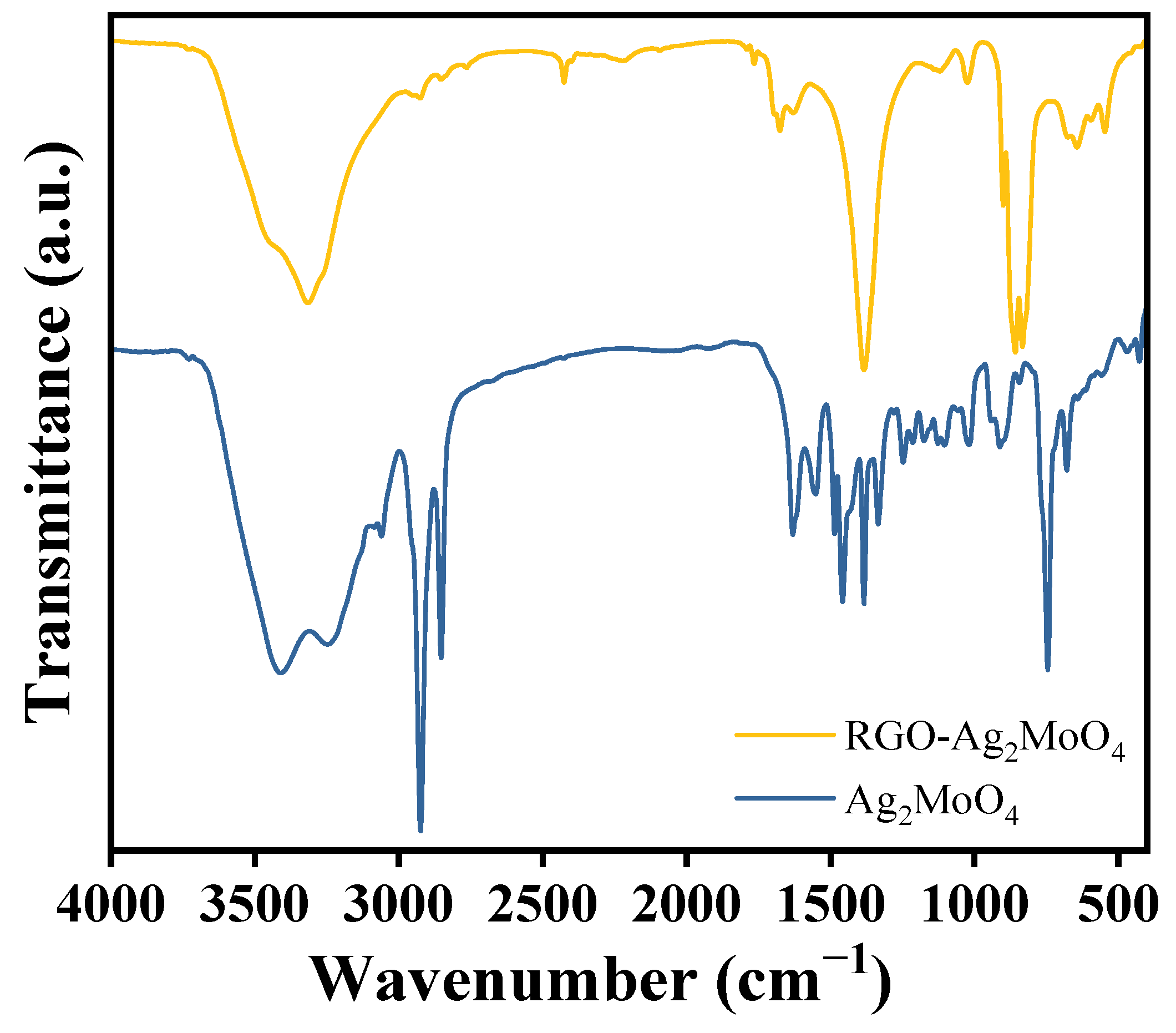
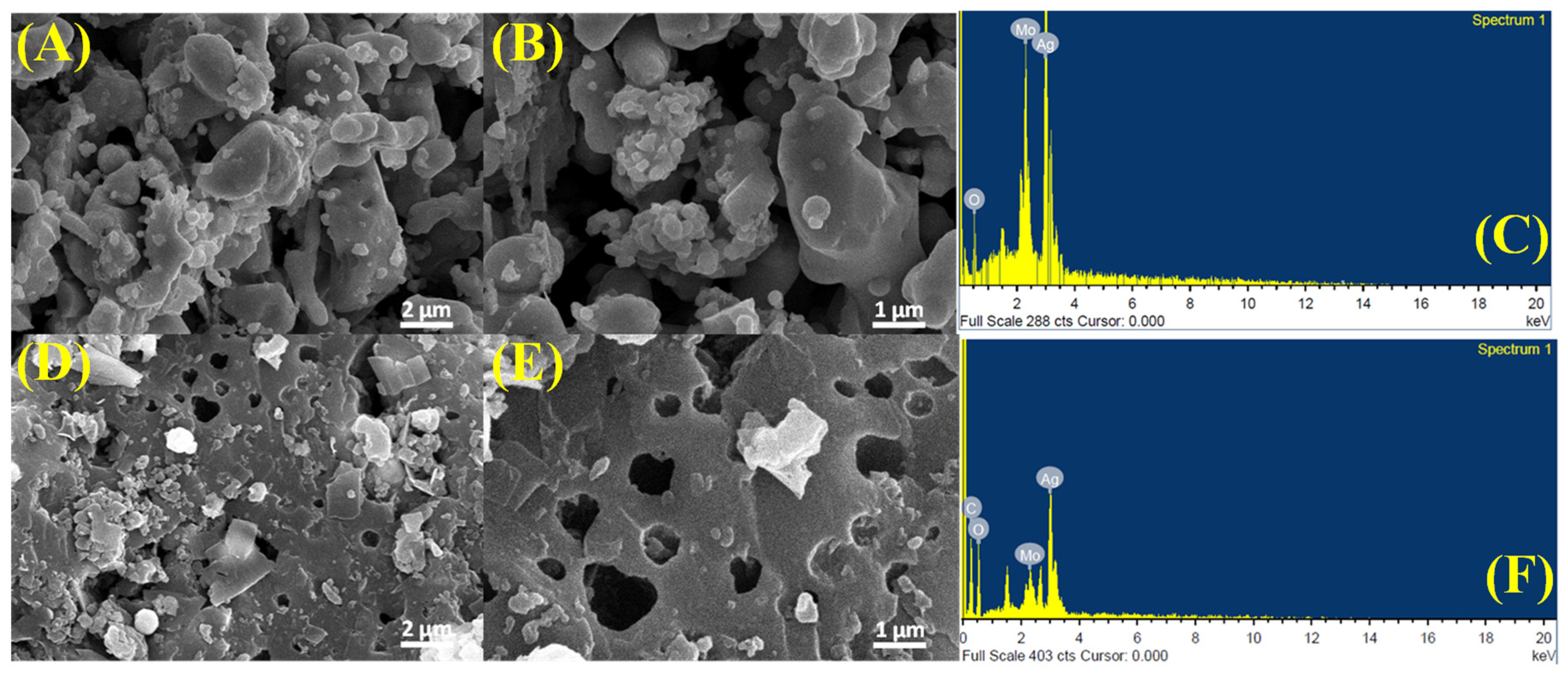
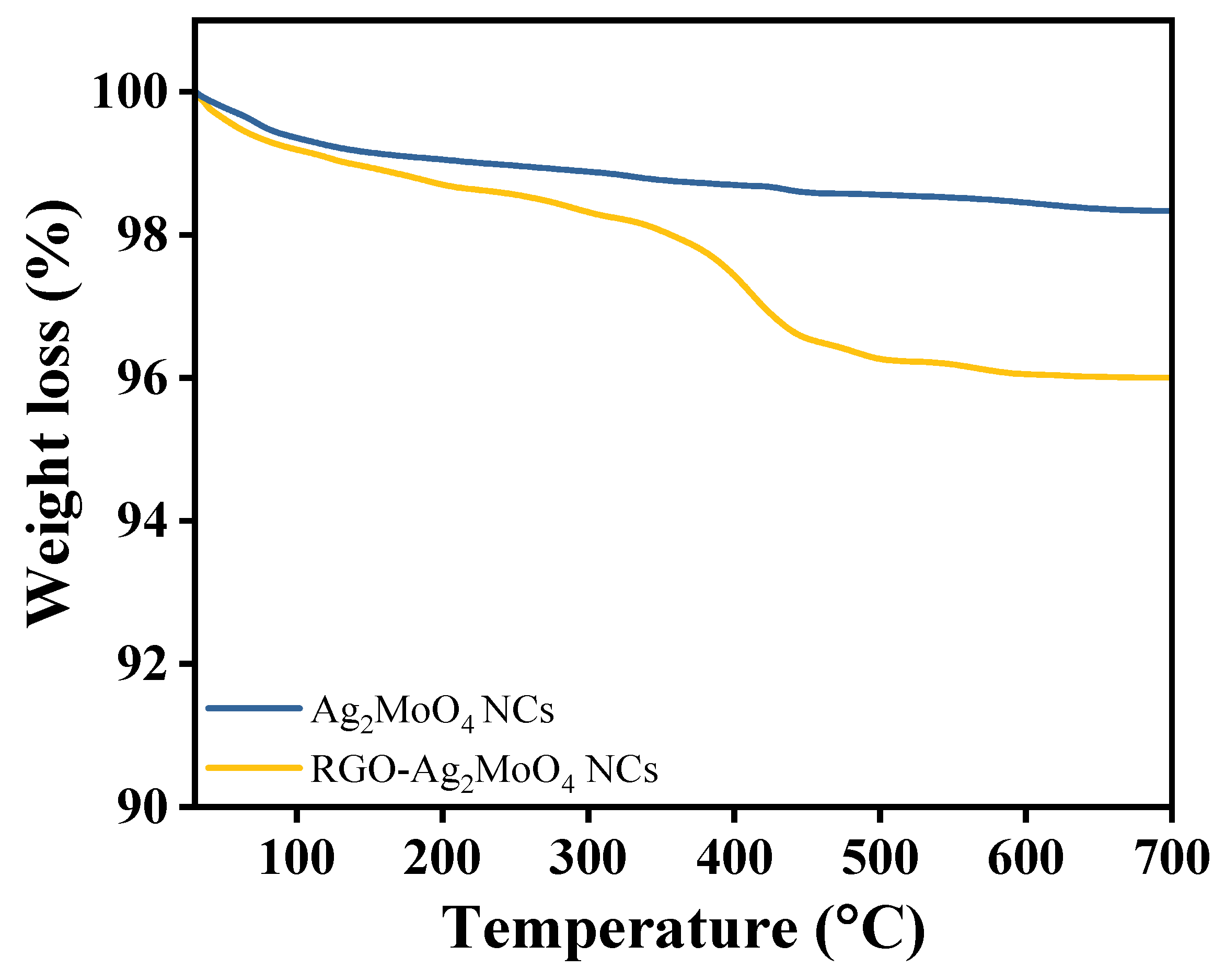
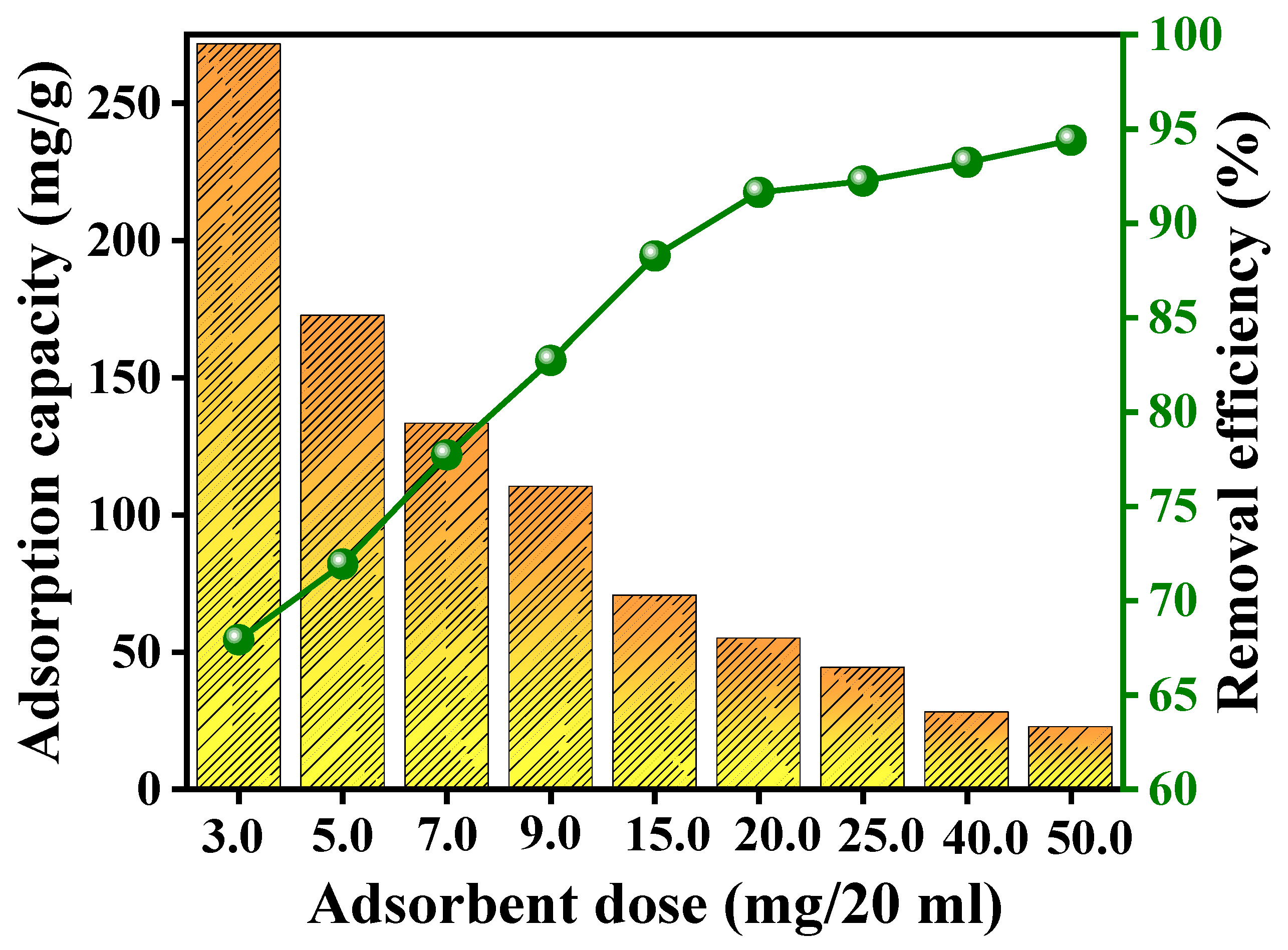


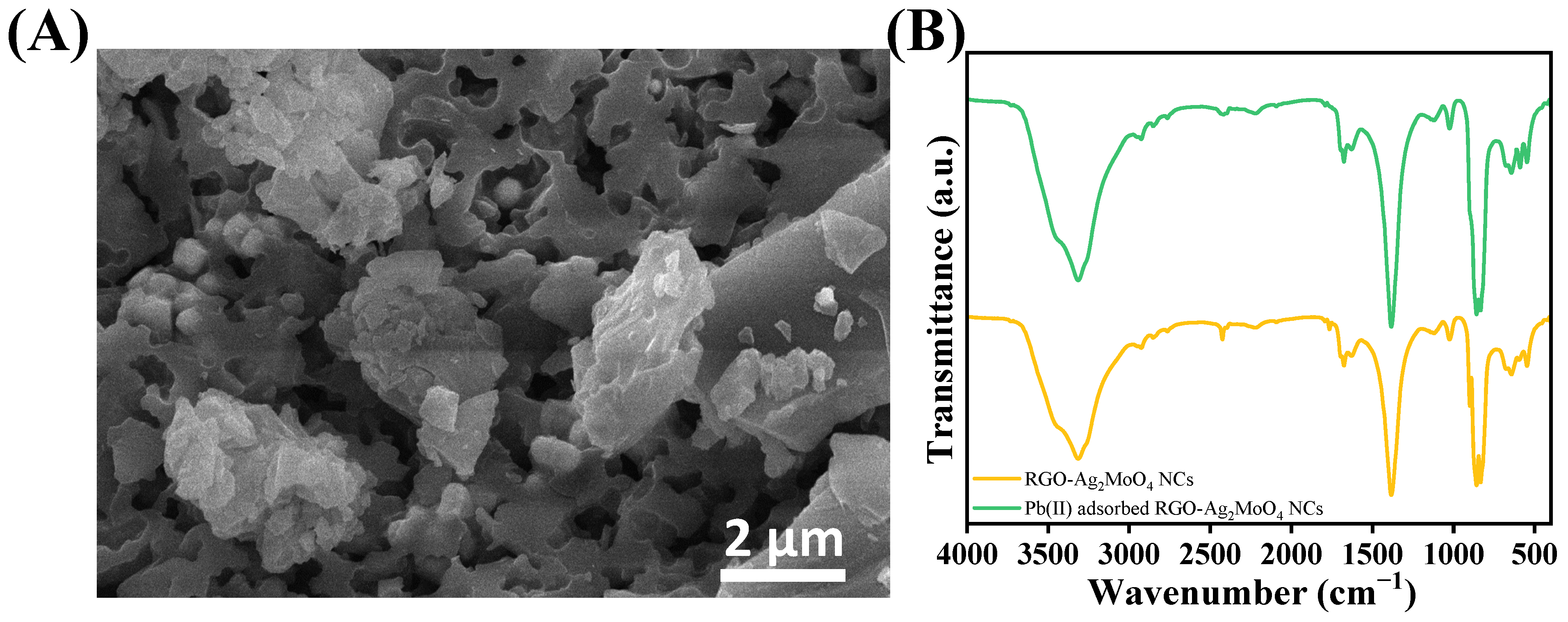
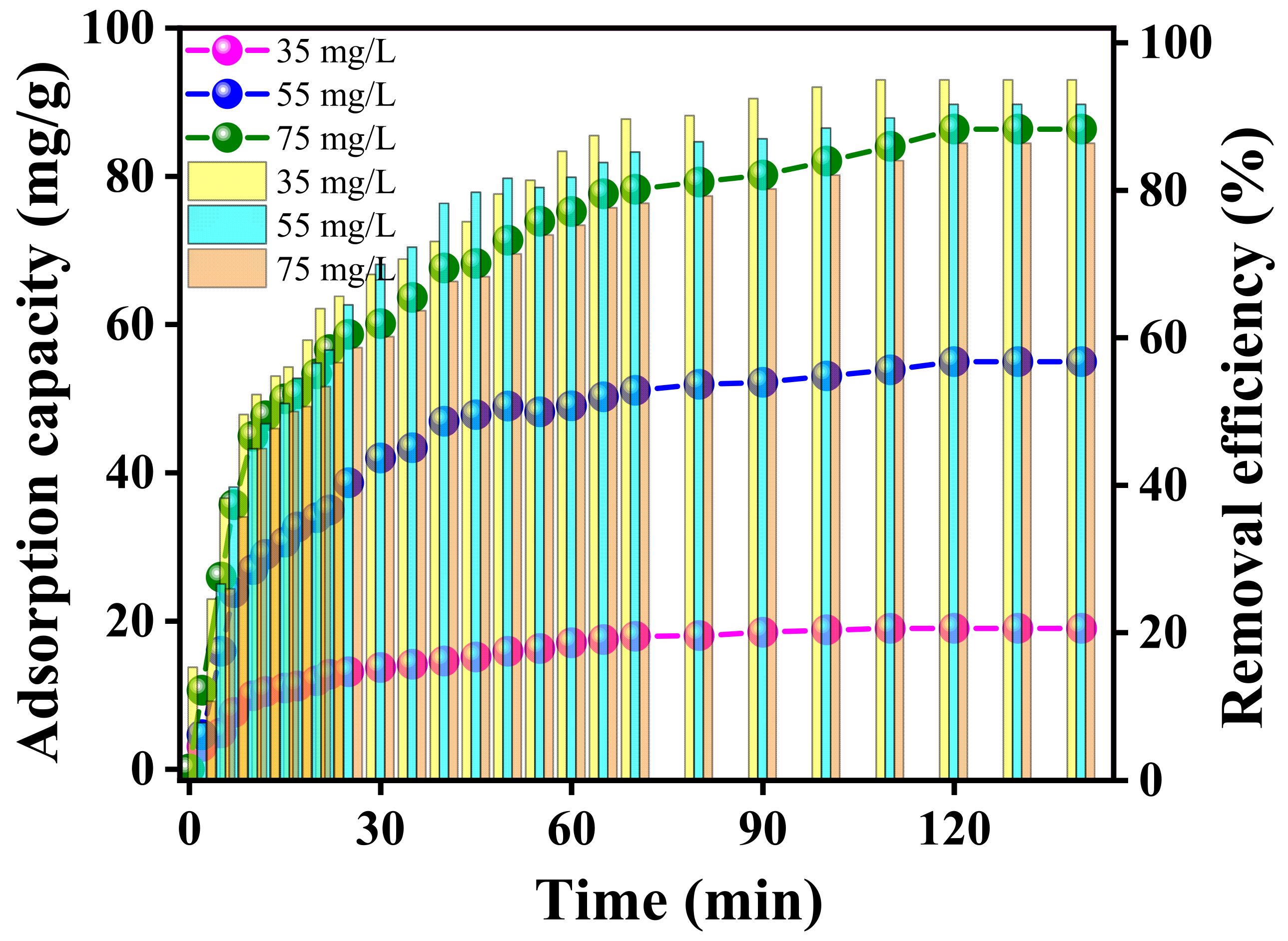
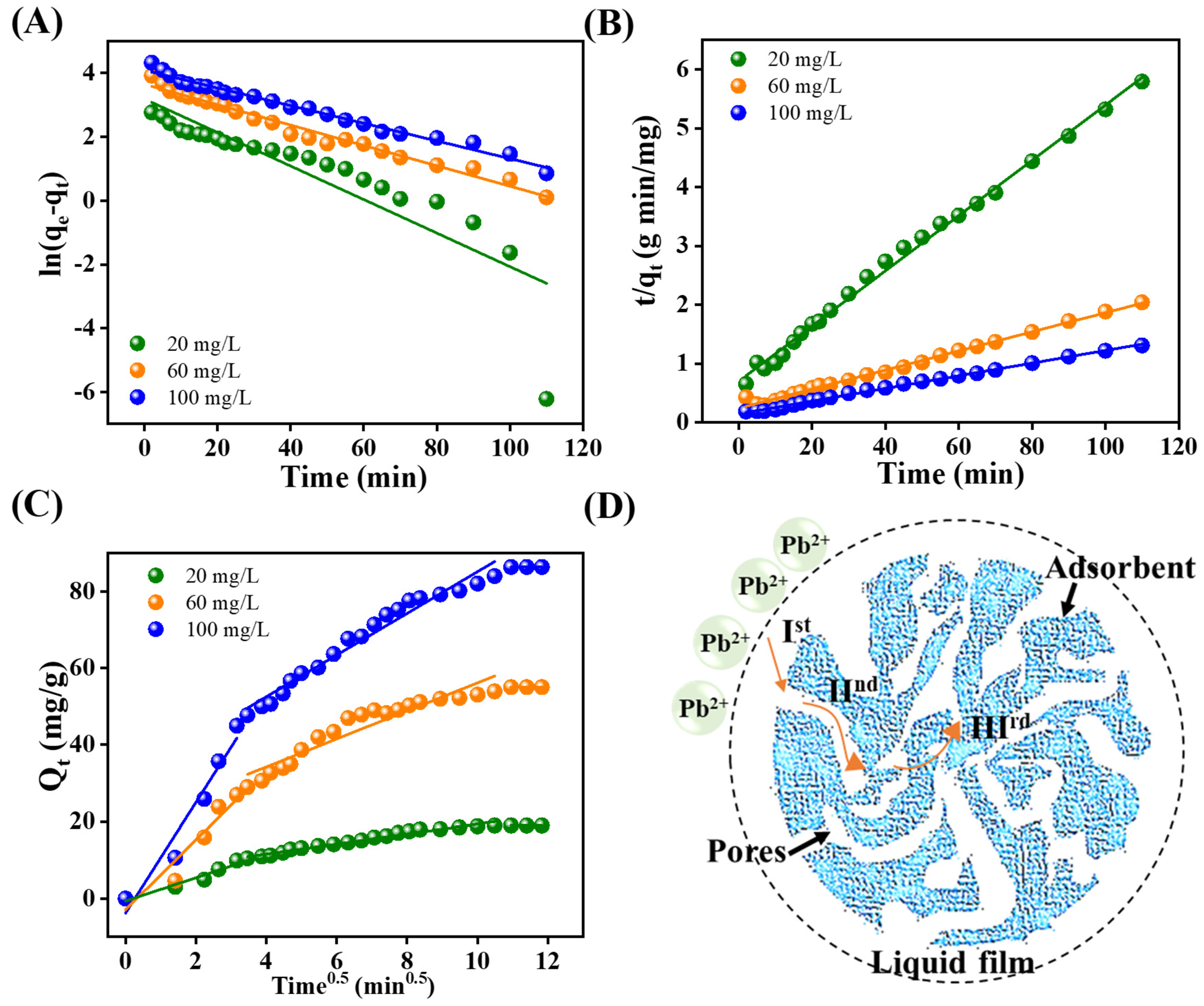


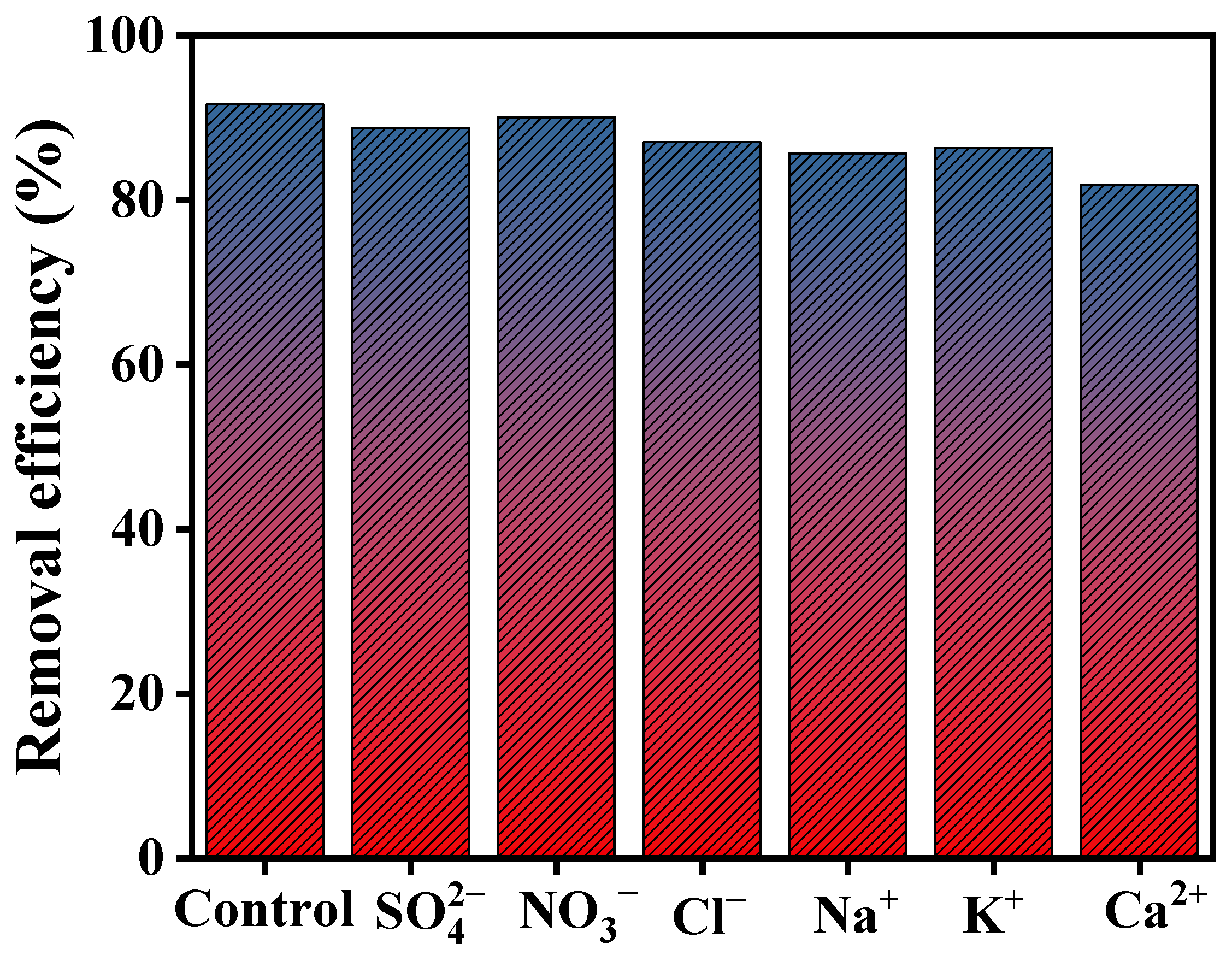

| Kinetics | Parameters | |||
|---|---|---|---|---|
| Experimental | Co (mg/L) | 20 | 60 | 100 |
| Qexp (mg/L) | 18.992 | 54.983 | 86.372 | |
| Pseudo-first-order | Qfo (mg/g) | 24.312 | 38.474 | 59.781 |
| K1 (g/mg min) | 0.0469 | 0.0162 | −0.0277 | |
| R2 | 0.772 | 0.979 | 0.983 | |
| Pseudo-second-order | Qso (mg/g) | 21.321 | 61.666 | 92.981 |
| K2 (g/mg min) | 3.136 × 10−3 | 1.079 × 10−3 | 4.4056 × 10−5 | |
| R2 | 0.996 | 0.990 | 0.996 | |
| Weber–Morris intraparticle diffusion model | Ki,1 (mg/g min−1/2) | 3.043 | 9.081 | 14.382 |
| R2 | 0.945 | 0.914 | 0.949 | |
| Ki,2 (mg/g min−1/2) | 1.297 | 3.651 | 5.446 | |
| R2 | 0.972 | 0.901 | 0.967 | |
| Ki,3 (mg/g min−1/2) | 0.00228 | 0.00341 | 0.00341 | |
| R2 | 0.998 | 0.960 | 0.960 |
| Isotherms | Parameters | Pb(II) |
|---|---|---|
| Langmuir | QL (mg/g) | 128.942 |
| KL (L/g) | 0.1432 | |
| R2 | 0.9982 | |
| Freundlich | KF (mg/g) | 25.151 |
| nF (L/g) | 0.448 | |
| R2 | 0.9766 |
| Adsorbents | Adsorption Capacity (mg/g) | Dose (g/L) | pH | Time (h) | Temperature (K) | Ref. |
|---|---|---|---|---|---|---|
| RGO-Fe0/Fe3O4-PEI | 60.24 | 0.05 | 6 | 1 | 268 | [26] |
| GO/Fe3O4 | 38.5 | - | 6 | 2 | 293 | [27] |
| Carbon/iron oxide | 67.1 | 2 | 6 | 1 | 323 | [28] |
| GO-polydopamine | 53.6 | - | - | 5 | 302 | [29] |
| TiO2/rGO | 9.1 | 1 | - | 2 | - | [30] |
| Fe3O4@SiO2-MnO2 | 35.1 | 0.5 | 4 | 24 | 298 | [31] |
| ZnO/Carbon nanofibers | 92.59 | 1 | 7 | 45 min | - | [32] |
| RGO-Ag2MoO4 NCs | 128.94 | 1 | 6 | 2 | 298 | Our result |
| T(K) | ∆S° (J/K/mol) | ∆H° (kJ/mol) | ∆G° (kJ/mol) | R2 |
|---|---|---|---|---|
| 298 | 152.068 | 37.995 | −7.286 | 0.9989 |
| 303 | −8.101 | |||
| 313 | −9.656 | |||
| 323 | −11.083 |
Disclaimer/Publisher’s Note: The statements, opinions and data contained in all publications are solely those of the individual author(s) and contributor(s) and not of MDPI and/or the editor(s). MDPI and/or the editor(s) disclaim responsibility for any injury to people or property resulting from any ideas, methods, instructions or products referred to in the content. |
© 2024 by the authors. Licensee MDPI, Basel, Switzerland. This article is an open access article distributed under the terms and conditions of the Creative Commons Attribution (CC BY) license (https://creativecommons.org/licenses/by/4.0/).
Share and Cite
Shoeb, M.; Mashkoor, F.; Khan, M.N.; Jeong, C. A Facile Synthesis of RGO-Ag2MoO4 Nanocomposites for Efficient Lead Removal from Aqueous Solution. Molecules 2024, 29, 5152. https://doi.org/10.3390/molecules29215152
Shoeb M, Mashkoor F, Khan MN, Jeong C. A Facile Synthesis of RGO-Ag2MoO4 Nanocomposites for Efficient Lead Removal from Aqueous Solution. Molecules. 2024; 29(21):5152. https://doi.org/10.3390/molecules29215152
Chicago/Turabian StyleShoeb, Mohd, Fouzia Mashkoor, Mohmmad Naved Khan, and Changyoon Jeong. 2024. "A Facile Synthesis of RGO-Ag2MoO4 Nanocomposites for Efficient Lead Removal from Aqueous Solution" Molecules 29, no. 21: 5152. https://doi.org/10.3390/molecules29215152
APA StyleShoeb, M., Mashkoor, F., Khan, M. N., & Jeong, C. (2024). A Facile Synthesis of RGO-Ag2MoO4 Nanocomposites for Efficient Lead Removal from Aqueous Solution. Molecules, 29(21), 5152. https://doi.org/10.3390/molecules29215152








